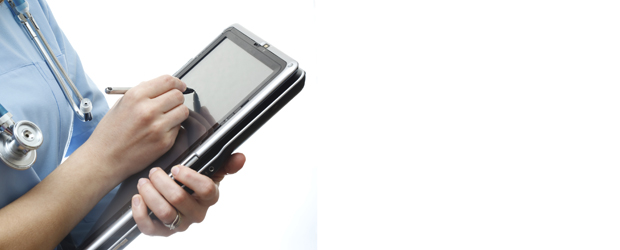Digital healthcare: The comfort factor of a paper trail


Some readers may be aware that I have Crohn's disease -- a gastrointestinal disorder where my immune system decides that the lining of my intestines is some alien invader looking for trouble.
This week I was hoping to have a normal week at work. I'm not. I'm instead having not-actually-a-bad-time in a local NHS hospital having a Crohn's flare-up properly managed. I'll be here all week. (Tip your waitress/nurse.)
During my career, I've built systems like the ones used in the hospital here. The reason why I'm writing this piece (apart from having a lot of time to kill) is that there's something that I've been missing and is generally missing from these system designs.
Patients need to hold something, to be able to touch something, that gives them a sense of control over the progress of their care. And I'm not sure that thing can be digital. I suspect patients, and their relatives, need "paper tokens."
Let me explain...
Arrival
I arrived at the hospital on Friday night in an ambulance. One criticism often leveled at the NHS is the amount of paperwork that frontline staff are expected to complete. The various people who conveyed me to the hospital spent a long time filling out this complex, A3-sized form with every piece of information they could lay their hands on.
On arrival at the hospital, this sheet of paper was used to book me in. I went to see the doctor, who examined me and told me that I would be admitted. I waited on a bed in his room while he printed out a letter and a form, sealed it in an envelope and gave it to me.
I then returned to wait in the emergency room, but the important thing for me here as a patient was that I had this envelope. This envelope had become a token, a physical indicator that I was in the system and that I was starting to be looked after. Not "seen", not "processed" -- as a patient I wanted neither of those things. I wanted to get better.
As a systems designer, my first objective would be to digitize the lot and get rid of the paper. The ambulance crew would have uses an iPad. Cellular data would have conveyed the information to the doctor before the patient got there. The patient would have be seen by the doctor, and whatever database records had to be created would have been and the patient would have been sent out to wait. But, in this digitized scenario, the patient would have nothing to hold onto, nothing to confirm for them, minute-by-minute, that they were in the system.
In that purely digital system, there's nothing for the patient to touch that confirms to them that they haven't been lost and forgotten. It's something that says, "patient, be patient."
Ward 4
The next morning I was transferred to a ward where -- having sorted out the basics of my presentation during the night -- my actual treatment began..
At the foot of my bed was a folder and a chart preprinted on thick paper where I could see just what was happening with my observations and medications. I could lean forward, pick it up, and see. I didn't have to ask anyone; it was simply there.
As a patient, I'm finding that I don't actually trust this system. How do I know the nurse is using the system correctly and storing my details against the correct patient record?
Ward 4 had no automated systems at all, apart from an office-based system that they would use to handover between the two shifts that managed the wards. I noticed that the nurses, when taking observations, would take some paper handtowel (the sort of paper one would use for drying hands after washing) and use this to record the observations before transferring them to the paper forms in the binder.
(I have learned that this "nurse's notebook" isn't actually uncommon and has been done for years -- it's not necessarily an indictment of NHS funding.)
Again, from my perspective as a patient, the whole system is very contained and very obvious. It's a very mechanical system with no complex technology. I can see everything step-by-step. I know I'm being monitored, and I know where that information is.
But as a systems designer, it's not how I'd do it, which brings me to the next ward...
Ward 11
A couple of days later I was transferred to Ward 11. This ward operates "electronic observations" using an open source system called Wardware which runs on iPod touches used by the nurses. As they go around taking observations, they tap the data into the iPods and it goes into a central database.
Interestingly though, I've still got the binders at the foot of the bed. They record the observations using Wardware and then write them back into the binder.
As a patient, I'm finding that I don't actually trust this system, which -- given what I do for living --- seems ridiculous. How do I know the nurse is using the system correctly and storing my details against the correct patient record? It also seems fussy and fiddly because the iPod devices are so small. Something that looks fiddly to use doesn't make me feel confident, as a patient. (I'm not saying any of this is rational. But as a patient in hospital, I'm not supposed to be rational.)
But again, as a patient, I still need that token. I need to know I can reach down and touch and go through the information in that binder. If any of these systems were taken away -- if at the end of my bed there was an RFID tag and everything was done through an iPad, I would be impossibly lost.
As a systems designer, this is exactly how I would approach the problem. Of course, tagging each bed with RFID is a great idea. Of course, whacking every bit of data in SQL Server and having it available to everyone who works in the hospital is a good idea.
It's that last point that's the problem – every time I approach systems design like this I've only ever considered the user community; i.e., the people trained to use the systems. I've never considered the ultimate consumers.
I've drunk as much post-PC Kool-Aid as it's possible to drink. Despite that, do I think giving visiting relatives an iPad when they arrive as the hospital and letting them look through their loved one's notes is a good idea? No -- that's just a ridiculous idea. If a 70-year-old son turns up to visit his 95-year-old mother, he likely at that point does not want to use an iPad -- for perhaps the first time.
For me, there's an analogue here with digital money. Digital money is all well and good, but the only technology required to receive paper money is an open hand. It's the same thing here: Patients and their relatives need to be able to access this information in a way that is free from fussy technology.
The trick, I feel, is to balance it. Being able to get digital CT images out of a scanner and onto every workstation and mobile in the hospital is undoubtedly a good thing. There are countless other examples of physical-facing systems in play that bring huge benefits to healthcare providers.
The people at the end of the chain -- the patients and the people they love -- need to be included, too. Today, these paper-based systems that provide "tokens" to hold onto and pass around seem -- to me at least, today, as a patient -- these systems seem irreplaceable.
See also: